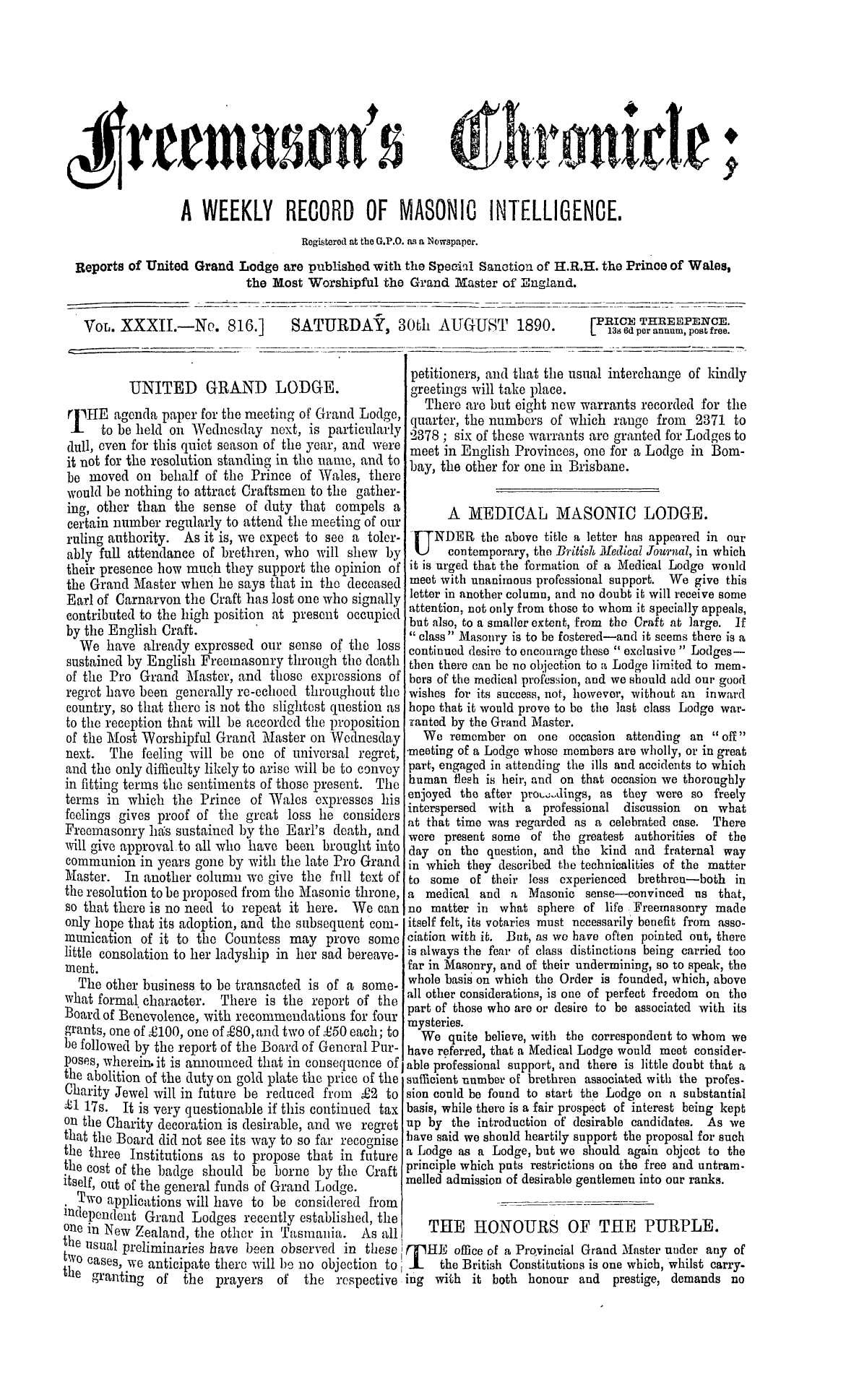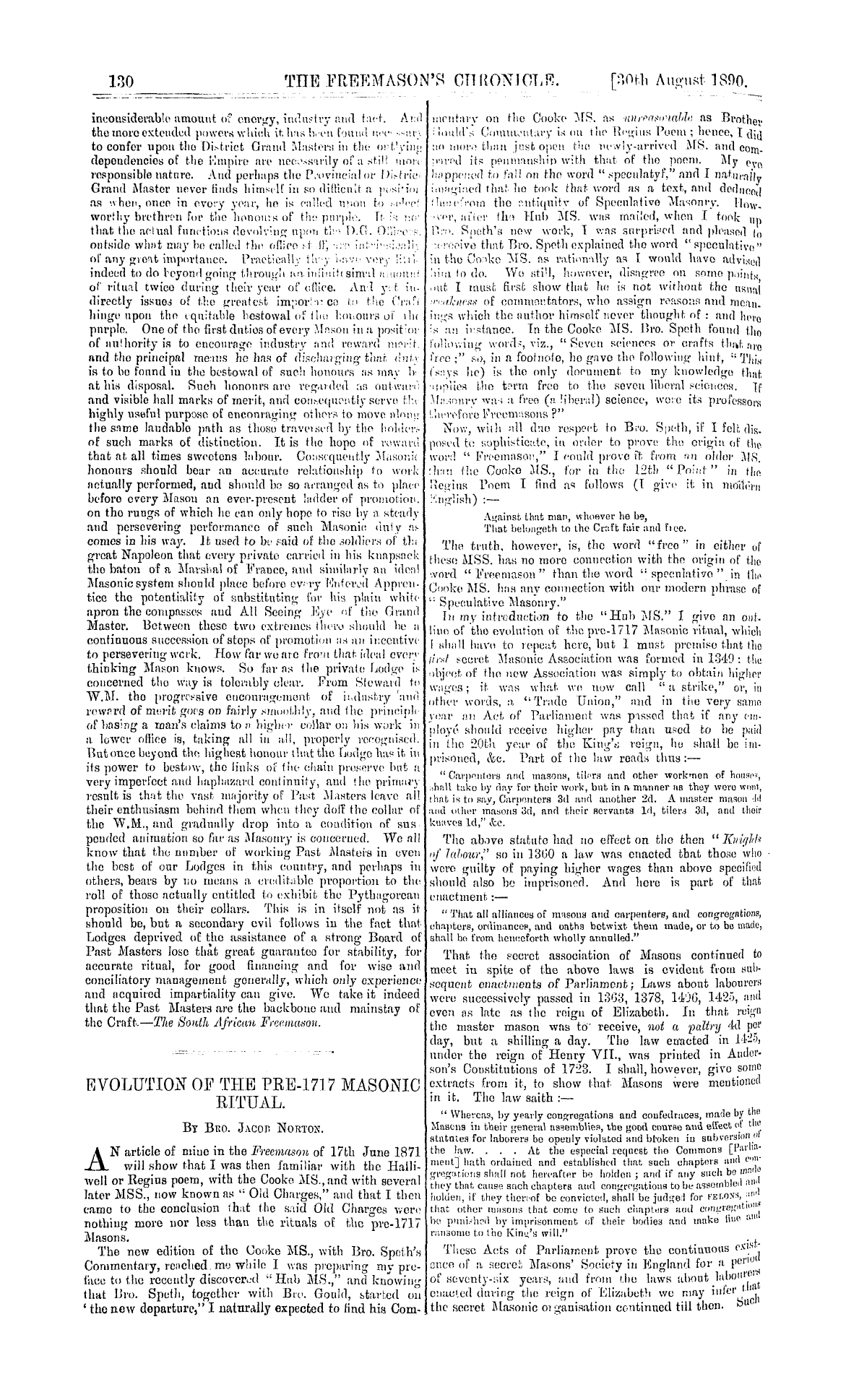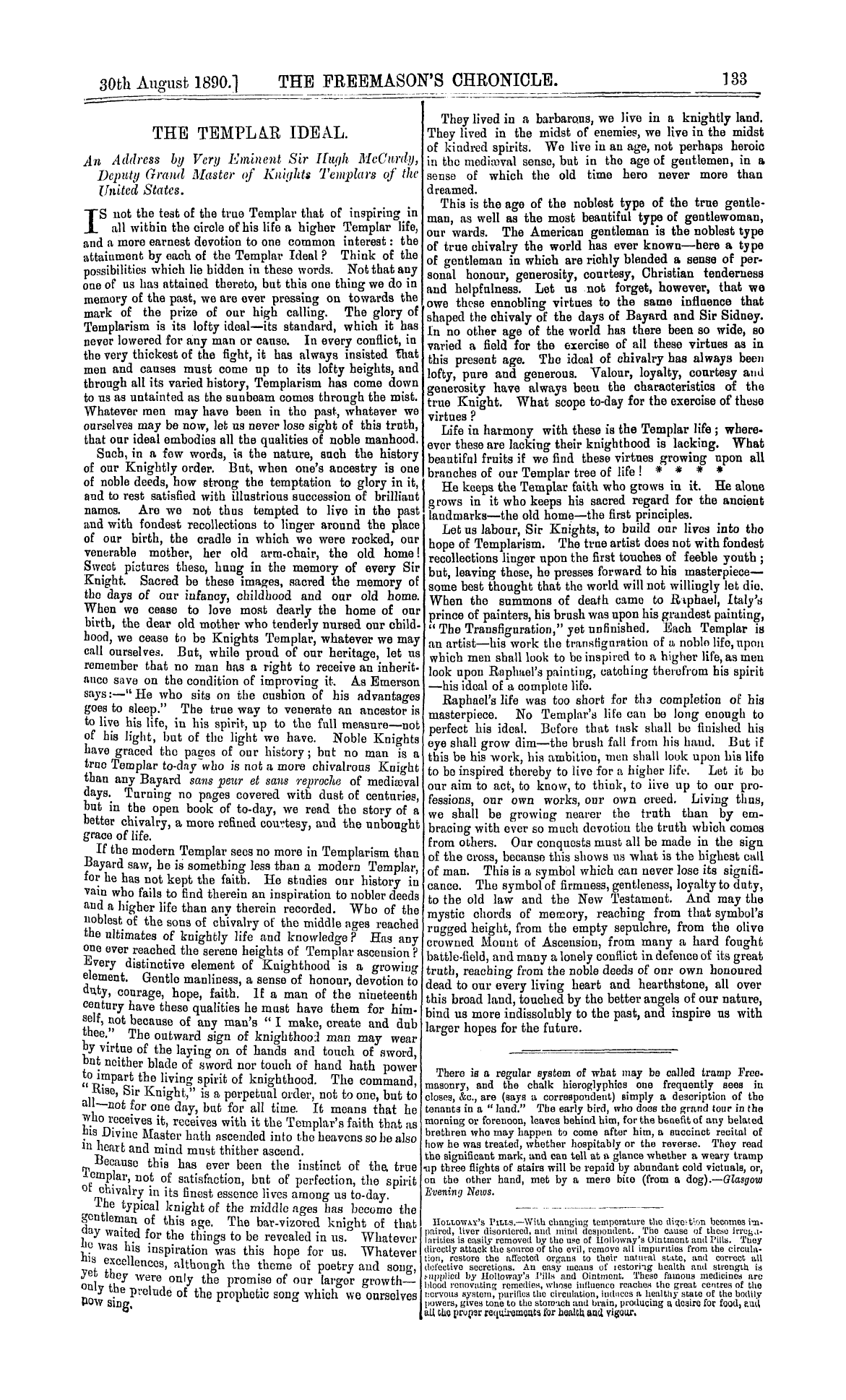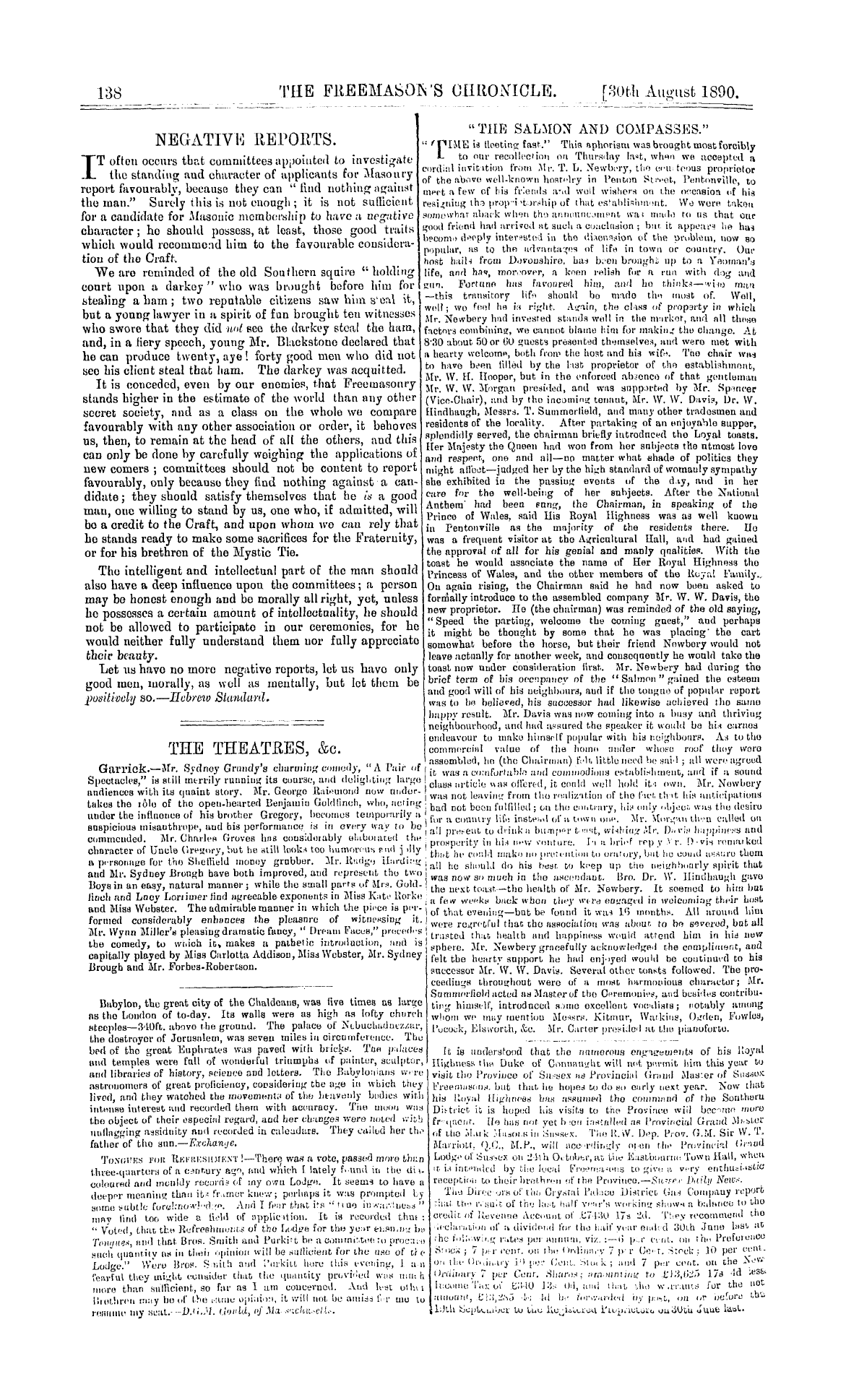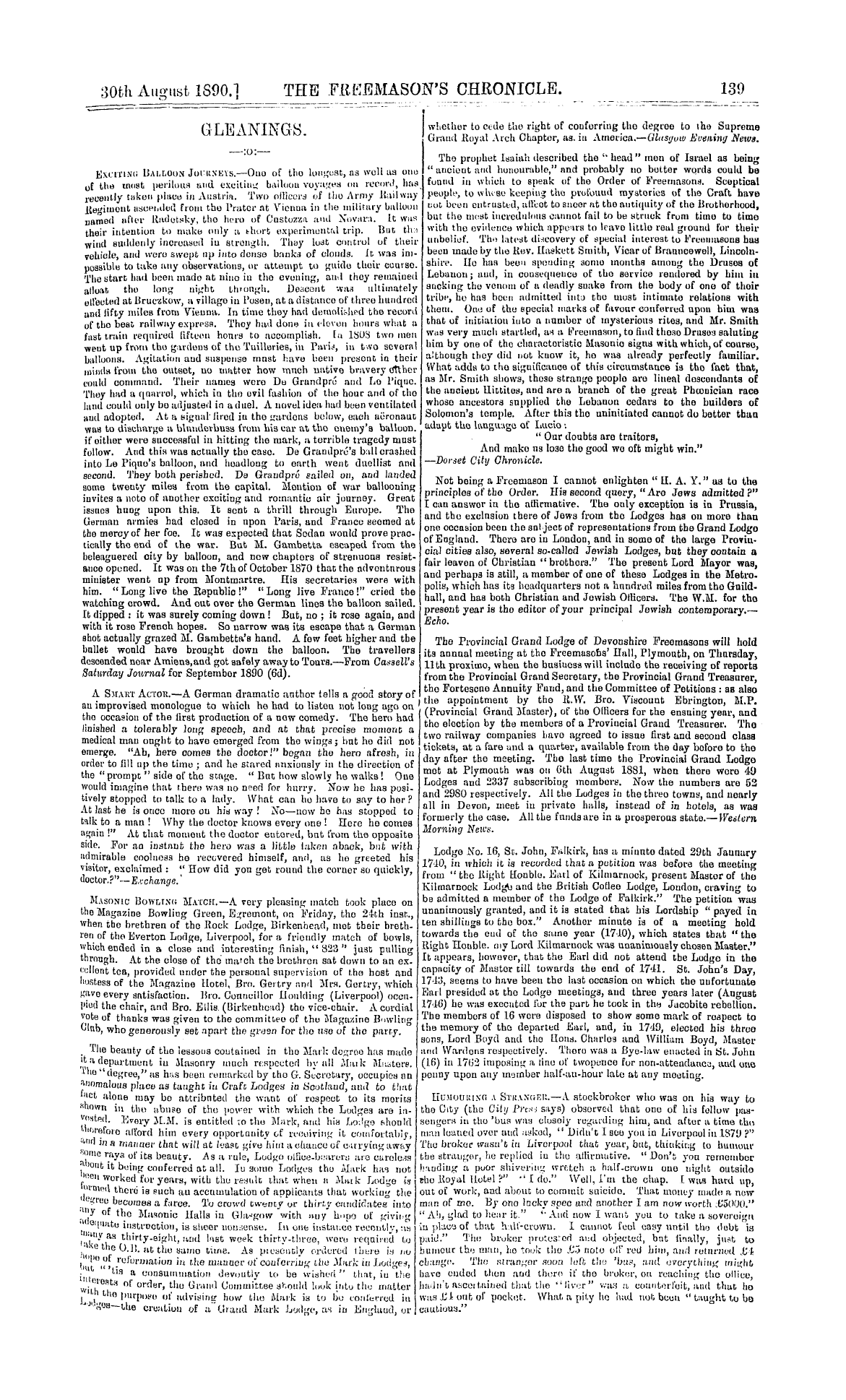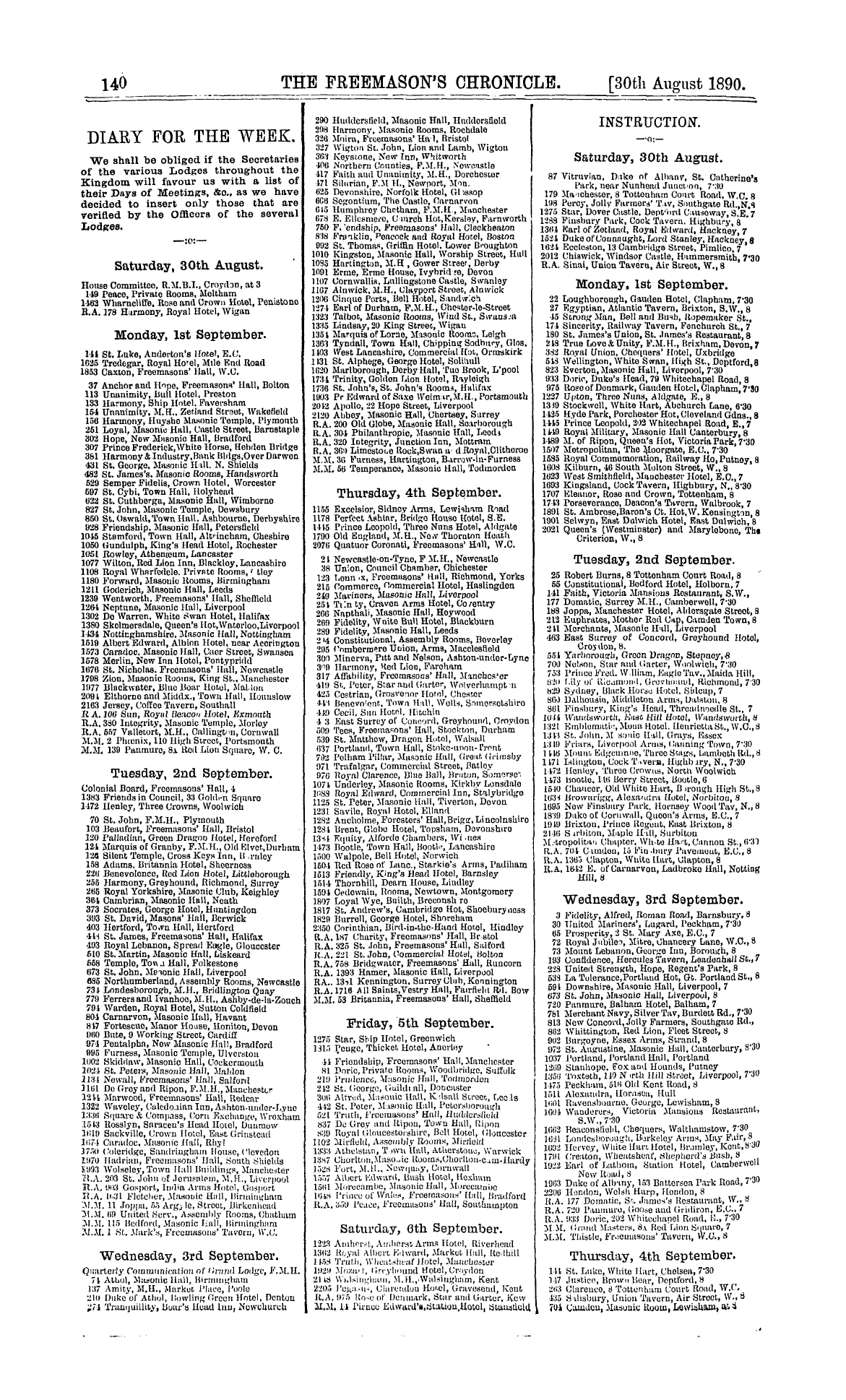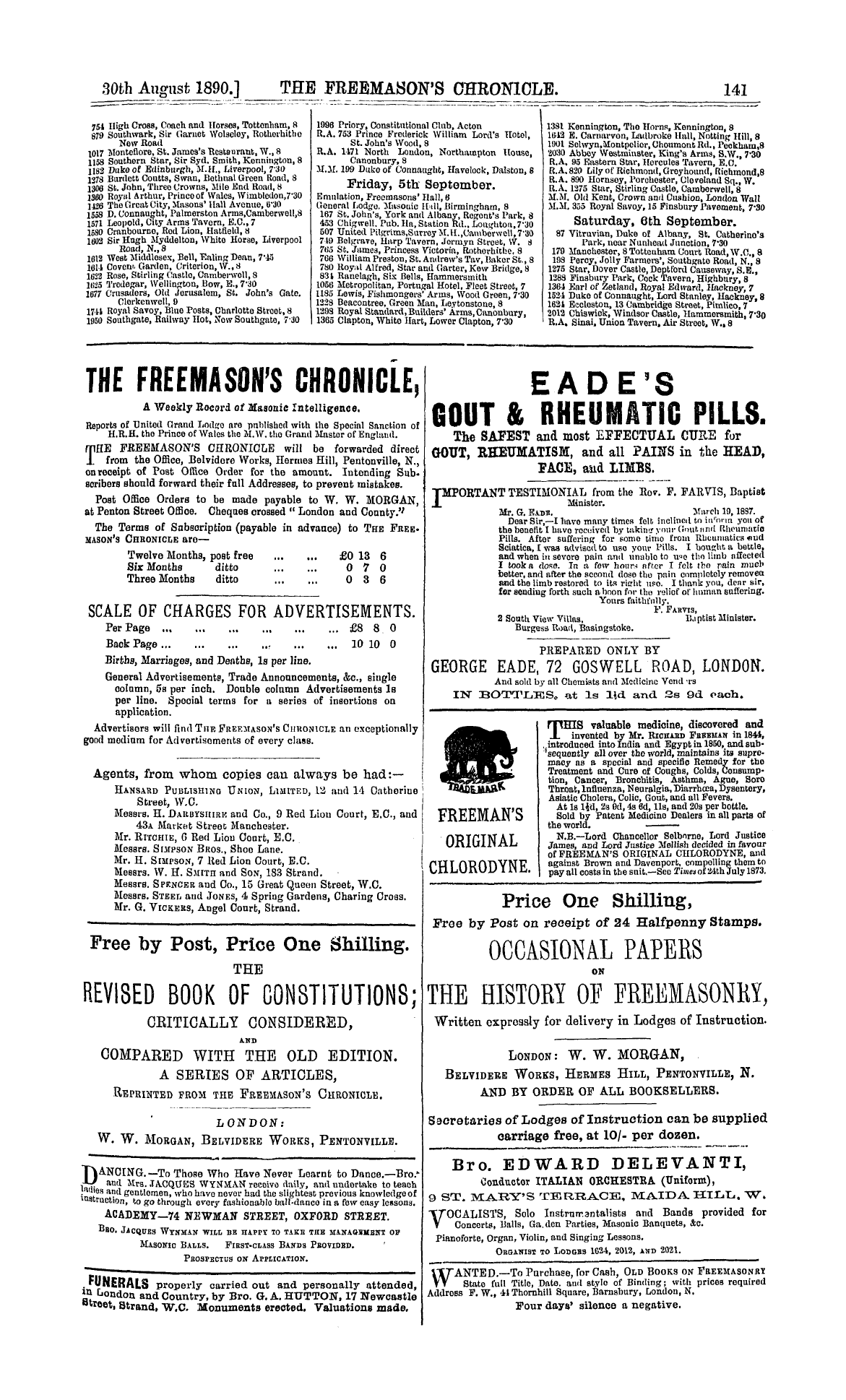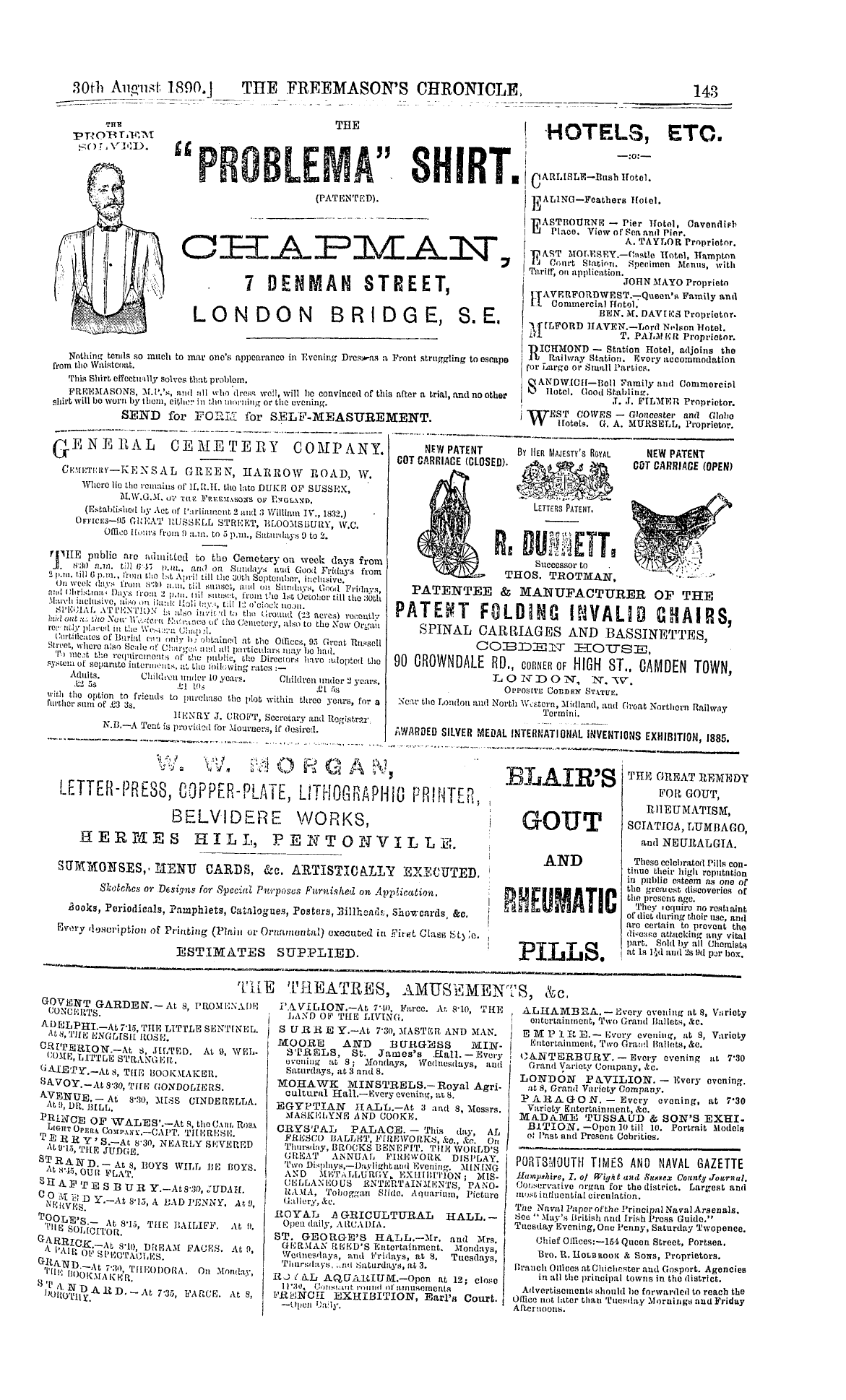-
Articles/Ads
Article EVOLUTION OF THE PRE-1717 MASONIC RITUAL. ← Page 2 of 3 Article EVOLUTION OF THE PRE-1717 MASONIC RITUAL. Page 2 of 3 →
Note: This text has been automatically extracted via Optical Character Recognition (OCR) software.
Evolution Of The Pre-1717 Masonic Ritual.
n secret society must have had a ritual . It secerns , however , that up to the middle of the 15 th century the Masons' ritual did not difl ' r materially from those of other trade iissociuti . ms , that is , the laws were read to the candidate , which lu ; had to swear to observe , and
in addition Inert !" , some words and signs were communicated to him , to which he had to swear that he would keep them secret . In that alone the Masons differed from other t-tcle v * misntions . But whon they learned from the poet that iimclid was the founder of
Masonry , and that the first Masonic Lodge consisted of noblemen ' s sons , aud that King Athelstan , with "dyvers lords , Dukei , er ' ys , barms , Knysthys , Squwyers , and many mo , " loved Masons , and gave them a charter and Charges , and tho brethren of course supposed that the
poet was a great Masonic luminary . Besides which , the poet explained all about the seven sciences . All -which must have tickled the brethren , hence it is reasonable to suppose that they added the poet ' s legends and the seven sciences to tho Charges , and thereafter thc enlarged ritual
was read to candidates . The Craft ' s Constitntions , in Catholic times , usually began with an invocation to the Trinity , to tho Virgin , and to a patron saint or saints . Tho poem begins with the
legends , followed b y the charges , and next comes a prayer to " God Almight , to his modor Mary bright , " and to the four crownd martyrs ( the then English Masons patron saints ) , together with a Catholic legend abont these four paints .
In 1459 the Strasburg Masons organized a Craft asso
( nation , and they prefaced their code of laws , as follows : — "In tho namo of the Father , and of tho Son , and of the Holy Ghost , and onr gracious mother 'Mary , and of her beloved servants tho four crowned martyrs of everlasting memory . "
Our Masonic poem was written very near tho year 1459 , and from it wo learn that the four crowned martyrs wero patrons of tho English Masons too . Bro . Findel thorofore imagined that tho English Masons borrowed their
patron saints Irom tho Strasbnrg Masons . 1 . am sorry to disagree with Bro . Findel . Be it remembered that in the middle ages an organization or a society would not exist a month without having a patron saint or saints . Now in 14- ') 9 the English Masonic organization was ono hundred
and ten years old , while tho Strasbnrg organization was then bran new . If therefore there was then any borrowing of patron saints on either side , it is much more probable that , the Germans borrowed their patron saints from the old lOnglish Masonic organization than rice versa , and it is
not ^ impossible that the Strasbnrg Masons not only got their patron saints from the English Masons , but may have copied the heading of tho English Masonic Charges too . ^ And here I cannot refrain from adding , for tho information of our good but deluded Bro . MncCalla , and for
¦ very pious American Masonic editors , that whereas in 14-39 both the English and German Masons had the four hol y crowned martyrs for their patron saints , ifc seems to me therefore that the then Masons could not have known
that the two Saints John wero Masonic Grand Masters or even Masons , for otherwise they would have had the two Saints John for their patron saints , instead of the four martyrs .
It seems furthermore that , with thc addition t . o the ritual of tho legends and the seven sciences , that the Charges were improved with explanations suggested by the poet as to wh y and wherefore some of the laws were adopted . * or instance , a law existed since tho Conquest of England
oy the Normans , that if a bondman remained in a town for twelve months and a day , he became a freeman . This law was repealed during Edward HP ' s reign . In the poet ' s version of the Charges , he gives two reasons for tho " no
bondman " ^ law . First , because the master of the bondman Ran take him away at any time , and as tho brethren may rf ' u Pa with - the bondman , ifc might culminate iu a a o'M , And second , he says : —
By old time written I find , That an appreniieo ahonld be of gentle kind , And so sometimes great lords' blood Took the geometry that is fnlly good . i ow , whether the first reason was in the old Constitutions
not p * ' i 3 ' beforu fche ritufl 1 wns eatorged , I know of fh ' t * seccmt ' , eason was based on the invention " B n ° - ' & encl ' as the fil ' hue above indicates , viz ., ha / 1 t - written J fi , ul" tbi * therefore could not L' b 0 cn in the old Charges , but that it was in the new
Evolution Of The Pre-1717 Masonic Ritual.
Constitution is evident from its having been copied by tbo author of the Cooke MS . in his fourth Article of tho Charges . Tho ritual based on tho poet ' s imagination , as abovo indicated , lasted until the religious Reformation in the
16 th century . In the intervening time the code of laws or " Charges " wero reduced from 30 sections to 18 , half of which vhey still called " Articles , " and half were called "Points . " The patron saints and " moder Mary brig ht " lost their old brightness in the estimation of Protestants ,
and the ritual had to be modified . Just then tho right mau appeared in tbo right place . The author of the Cooke MS . came forward , with an array of authorities that might havo overawed in those days all the Oxford Professors and the whole bench of Bishops too . JEte convinced
the brethren that he had not onl y read tho Biblo , to which he refers no less than eleven times , with occasional allusions to tho Chapters , but that ho could further prove the antiquity of Masonry , from the father of history , from the Poller mticon , from De Imagine , from Imlonis , from Jleda ,
from Elhomolegiarum , from Methodius , irom hpiscopu- * , from Martinis , and "from many more . " Such a flood of erudition and learning must have swamped and washed away every particle of reason from tho brains of onr old brethren . Well , in the first place , ho discarded the Virgin ,
the saints , and the saints' legends from tho new ntti-l , and substituted a prayer addressed to God and tho God-head ; He made Edwin , a son of Athelstan , into a lover of Masons , who gavo tho Masons Charges , & c . ; ho retained the Euclid legend , the seven sciences , and also divided the Charges
into " Articles" aud "Points , " and added a cart-lo ; ui of new stories , beginning with Lamech , from tho 4 fch Chapter of Genesis down to King Solomon , lie said that Iving Hiram bad a sou who was Solomon ' s mastor 7 iiason , but tho
nameof tho son he did not give ; that Abraham taught iviehd tho science of Geometry ; that King David loved Ma . soas , and gave them Charges , and ho began to build the Temple ; that Py thagoras , in a chronicle , vouched for tho foundation of the sciences by Lamech's sons . He also Masoui / .- 'd
Charles Mattel , and St . Alban , whom ho made into iho King ' s Steward , and who , of course , loved Masons , ;¦; ¦ ¦• vo them Charges , and increased their wages . All which wnti embodied in the new ritual , which is known to us a-. Iho Matthew Cooke MS .
Tho next Masouic illuminator appeared abont tho end of tho 10 th century , probably in 1583 , or thereabouts . Me revised tho Cooke MS ., pruned off its superfluities : ho altered tho prayer ; ho Masonized the City of York ; ! ic gave a name to King Hiram ' s son , the builder of Solomon ' a
Temple ( but abont the name or that son future knr . od scribes differed ); he added the Nymus Greens story ; iio introduced tho fashion of swearing on the Bible ; ho era ;¦•; -d classifying the Charges as "Articles" aud "Points , " ; vtd
wound up the ritual with "So help you God , " Abe . In short , it is possible that tho Grand Lodge MS . which Bro . Sadler published in bis " Facts and Fictions , " to which I shall hereafter refer , was written by that luminary ; which ritual sufficed to supply Masonic light until 1717 .
For near twenty years I believed that tho Poem was tho oldest Masonic MS . we have . Next camo tho Cooke , MS .
And next came the compiler and arranger of what we . now call " Old Charges " ; and that every fable wo havo was invented by the successive writers of the above described
MSS . Thus , the poet invented the Euclid and Athelstan legends , the author of the Cooke MS . invented a larger number of legends , and the last one invented the Nymus Grecus story , & c .
Bro . Speth , however , insists that the Regius Poem and the Cooke MS . were both written in the first half of tho
15 th century , but were written in different localities . The poet lived in a p lace where the soil was too poor for tho growth of legends , hence all he could find waa the Euclid and tho Athelstan legends , while the author of the Cooko
MS . lived in a place where the soil was rich , hence he found K tho Euclid and the Athelstan legends ( the latter somewhat differently shaped ) and a cart-load of other legends besides . And as to tbe idea that either of these authors invented
aDy legends , our Bro . Speth was too full of Masonic charity to entertain such a thought : he never suspected that a writer of a Masonic MS . could have invented a legend . Bro . Speth ' s reasoning failed to change my opinion , for
I could name a score or two of Masonic writers , Masonic lecturers , and Masonic editors—and some of them very pious—who could without any scruple repeat lies , defend lies , and invent h ' e 3 too . I shall , however , namo
Note: This text has been automatically extracted via Optical Character Recognition (OCR) software.
Evolution Of The Pre-1717 Masonic Ritual.
n secret society must have had a ritual . It secerns , however , that up to the middle of the 15 th century the Masons' ritual did not difl ' r materially from those of other trade iissociuti . ms , that is , the laws were read to the candidate , which lu ; had to swear to observe , and
in addition Inert !" , some words and signs were communicated to him , to which he had to swear that he would keep them secret . In that alone the Masons differed from other t-tcle v * misntions . But whon they learned from the poet that iimclid was the founder of
Masonry , and that the first Masonic Lodge consisted of noblemen ' s sons , aud that King Athelstan , with "dyvers lords , Dukei , er ' ys , barms , Knysthys , Squwyers , and many mo , " loved Masons , and gave them a charter and Charges , and tho brethren of course supposed that the
poet was a great Masonic luminary . Besides which , the poet explained all about the seven sciences . All -which must have tickled the brethren , hence it is reasonable to suppose that they added the poet ' s legends and the seven sciences to tho Charges , and thereafter thc enlarged ritual
was read to candidates . The Craft ' s Constitntions , in Catholic times , usually began with an invocation to the Trinity , to tho Virgin , and to a patron saint or saints . Tho poem begins with the
legends , followed b y the charges , and next comes a prayer to " God Almight , to his modor Mary bright , " and to the four crownd martyrs ( the then English Masons patron saints ) , together with a Catholic legend abont these four paints .
In 1459 the Strasburg Masons organized a Craft asso
( nation , and they prefaced their code of laws , as follows : — "In tho namo of the Father , and of tho Son , and of the Holy Ghost , and onr gracious mother 'Mary , and of her beloved servants tho four crowned martyrs of everlasting memory . "
Our Masonic poem was written very near tho year 1459 , and from it wo learn that the four crowned martyrs wero patrons of tho English Masons too . Bro . Findel thorofore imagined that tho English Masons borrowed their
patron saints Irom tho Strasbnrg Masons . 1 . am sorry to disagree with Bro . Findel . Be it remembered that in the middle ages an organization or a society would not exist a month without having a patron saint or saints . Now in 14- ') 9 the English Masonic organization was ono hundred
and ten years old , while tho Strasbnrg organization was then bran new . If therefore there was then any borrowing of patron saints on either side , it is much more probable that , the Germans borrowed their patron saints from the old lOnglish Masonic organization than rice versa , and it is
not ^ impossible that the Strasbnrg Masons not only got their patron saints from the English Masons , but may have copied the heading of tho English Masonic Charges too . ^ And here I cannot refrain from adding , for tho information of our good but deluded Bro . MncCalla , and for
¦ very pious American Masonic editors , that whereas in 14-39 both the English and German Masons had the four hol y crowned martyrs for their patron saints , ifc seems to me therefore that the then Masons could not have known
that the two Saints John wero Masonic Grand Masters or even Masons , for otherwise they would have had the two Saints John for their patron saints , instead of the four martyrs .
It seems furthermore that , with thc addition t . o the ritual of tho legends and the seven sciences , that the Charges were improved with explanations suggested by the poet as to wh y and wherefore some of the laws were adopted . * or instance , a law existed since tho Conquest of England
oy the Normans , that if a bondman remained in a town for twelve months and a day , he became a freeman . This law was repealed during Edward HP ' s reign . In the poet ' s version of the Charges , he gives two reasons for tho " no
bondman " ^ law . First , because the master of the bondman Ran take him away at any time , and as tho brethren may rf ' u Pa with - the bondman , ifc might culminate iu a a o'M , And second , he says : —
By old time written I find , That an appreniieo ahonld be of gentle kind , And so sometimes great lords' blood Took the geometry that is fnlly good . i ow , whether the first reason was in the old Constitutions
not p * ' i 3 ' beforu fche ritufl 1 wns eatorged , I know of fh ' t * seccmt ' , eason was based on the invention " B n ° - ' & encl ' as the fil ' hue above indicates , viz ., ha / 1 t - written J fi , ul" tbi * therefore could not L' b 0 cn in the old Charges , but that it was in the new
Evolution Of The Pre-1717 Masonic Ritual.
Constitution is evident from its having been copied by tbo author of the Cooke MS . in his fourth Article of tho Charges . Tho ritual based on tho poet ' s imagination , as abovo indicated , lasted until the religious Reformation in the
16 th century . In the intervening time the code of laws or " Charges " wero reduced from 30 sections to 18 , half of which vhey still called " Articles , " and half were called "Points . " The patron saints and " moder Mary brig ht " lost their old brightness in the estimation of Protestants ,
and the ritual had to be modified . Just then tho right mau appeared in tbo right place . The author of the Cooke MS . came forward , with an array of authorities that might havo overawed in those days all the Oxford Professors and the whole bench of Bishops too . JEte convinced
the brethren that he had not onl y read tho Biblo , to which he refers no less than eleven times , with occasional allusions to tho Chapters , but that ho could further prove the antiquity of Masonry , from the father of history , from the Poller mticon , from De Imagine , from Imlonis , from Jleda ,
from Elhomolegiarum , from Methodius , irom hpiscopu- * , from Martinis , and "from many more . " Such a flood of erudition and learning must have swamped and washed away every particle of reason from tho brains of onr old brethren . Well , in the first place , ho discarded the Virgin ,
the saints , and the saints' legends from tho new ntti-l , and substituted a prayer addressed to God and tho God-head ; He made Edwin , a son of Athelstan , into a lover of Masons , who gavo tho Masons Charges , & c . ; ho retained the Euclid legend , the seven sciences , and also divided the Charges
into " Articles" aud "Points , " and added a cart-lo ; ui of new stories , beginning with Lamech , from tho 4 fch Chapter of Genesis down to King Solomon , lie said that Iving Hiram bad a sou who was Solomon ' s mastor 7 iiason , but tho
nameof tho son he did not give ; that Abraham taught iviehd tho science of Geometry ; that King David loved Ma . soas , and gave them Charges , and ho began to build the Temple ; that Py thagoras , in a chronicle , vouched for tho foundation of the sciences by Lamech's sons . He also Masoui / .- 'd
Charles Mattel , and St . Alban , whom ho made into iho King ' s Steward , and who , of course , loved Masons , ;¦; ¦ ¦• vo them Charges , and increased their wages . All which wnti embodied in the new ritual , which is known to us a-. Iho Matthew Cooke MS .
Tho next Masouic illuminator appeared abont tho end of tho 10 th century , probably in 1583 , or thereabouts . Me revised tho Cooke MS ., pruned off its superfluities : ho altered tho prayer ; ho Masonized the City of York ; ! ic gave a name to King Hiram ' s son , the builder of Solomon ' a
Temple ( but abont the name or that son future knr . od scribes differed ); he added the Nymus Greens story ; iio introduced tho fashion of swearing on the Bible ; ho era ;¦•; -d classifying the Charges as "Articles" aud "Points , " ; vtd
wound up the ritual with "So help you God , " Abe . In short , it is possible that tho Grand Lodge MS . which Bro . Sadler published in bis " Facts and Fictions , " to which I shall hereafter refer , was written by that luminary ; which ritual sufficed to supply Masonic light until 1717 .
For near twenty years I believed that tho Poem was tho oldest Masonic MS . we have . Next camo tho Cooke , MS .
And next came the compiler and arranger of what we . now call " Old Charges " ; and that every fable wo havo was invented by the successive writers of the above described
MSS . Thus , the poet invented the Euclid and Athelstan legends , the author of the Cooke MS . invented a larger number of legends , and the last one invented the Nymus Grecus story , & c .
Bro . Speth , however , insists that the Regius Poem and the Cooke MS . were both written in the first half of tho
15 th century , but were written in different localities . The poet lived in a p lace where the soil was too poor for tho growth of legends , hence all he could find waa the Euclid and tho Athelstan legends , while the author of the Cooko
MS . lived in a place where the soil was rich , hence he found K tho Euclid and the Athelstan legends ( the latter somewhat differently shaped ) and a cart-load of other legends besides . And as to tbe idea that either of these authors invented
aDy legends , our Bro . Speth was too full of Masonic charity to entertain such a thought : he never suspected that a writer of a Masonic MS . could have invented a legend . Bro . Speth ' s reasoning failed to change my opinion , for
I could name a score or two of Masonic writers , Masonic lecturers , and Masonic editors—and some of them very pious—who could without any scruple repeat lies , defend lies , and invent h ' e 3 too . I shall , however , namo
